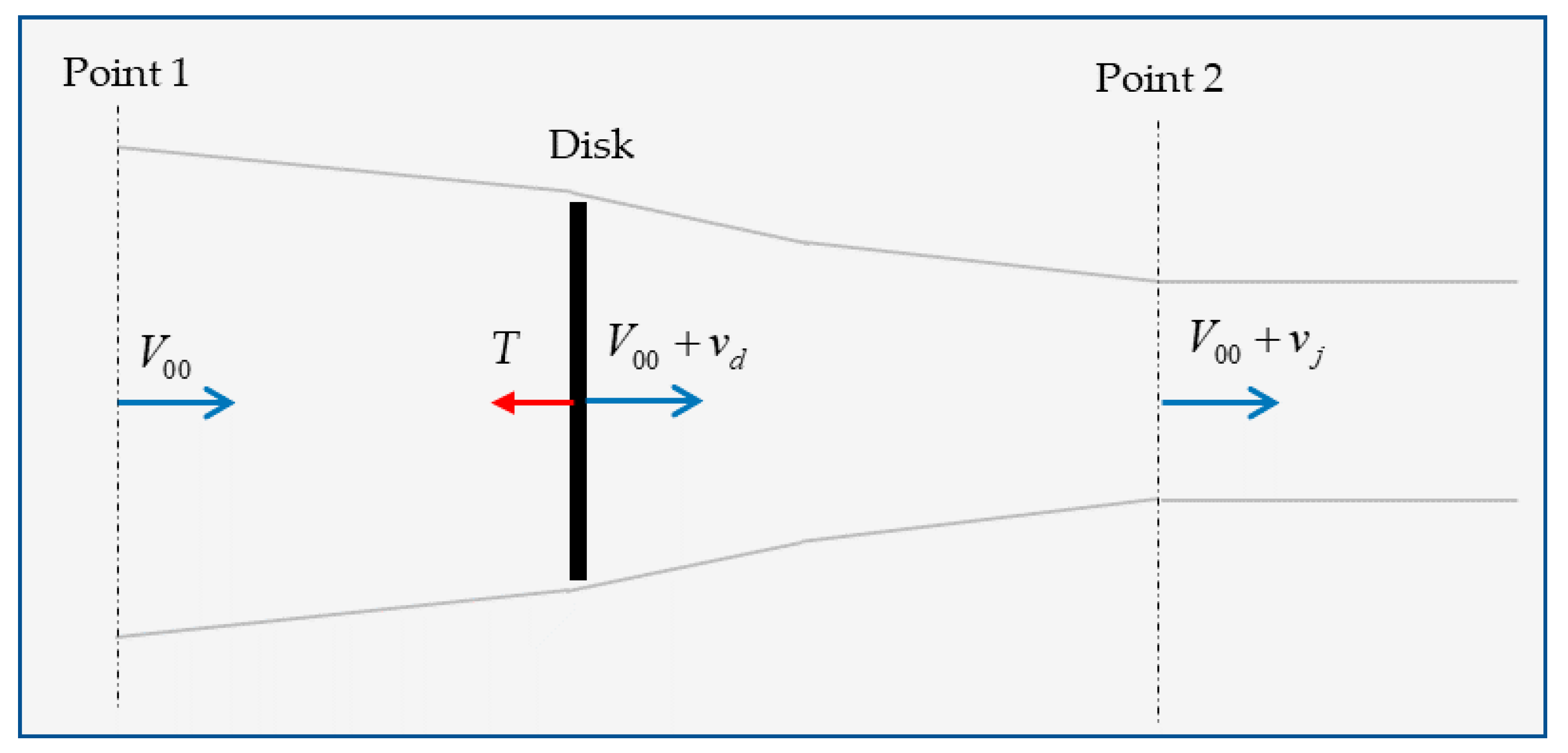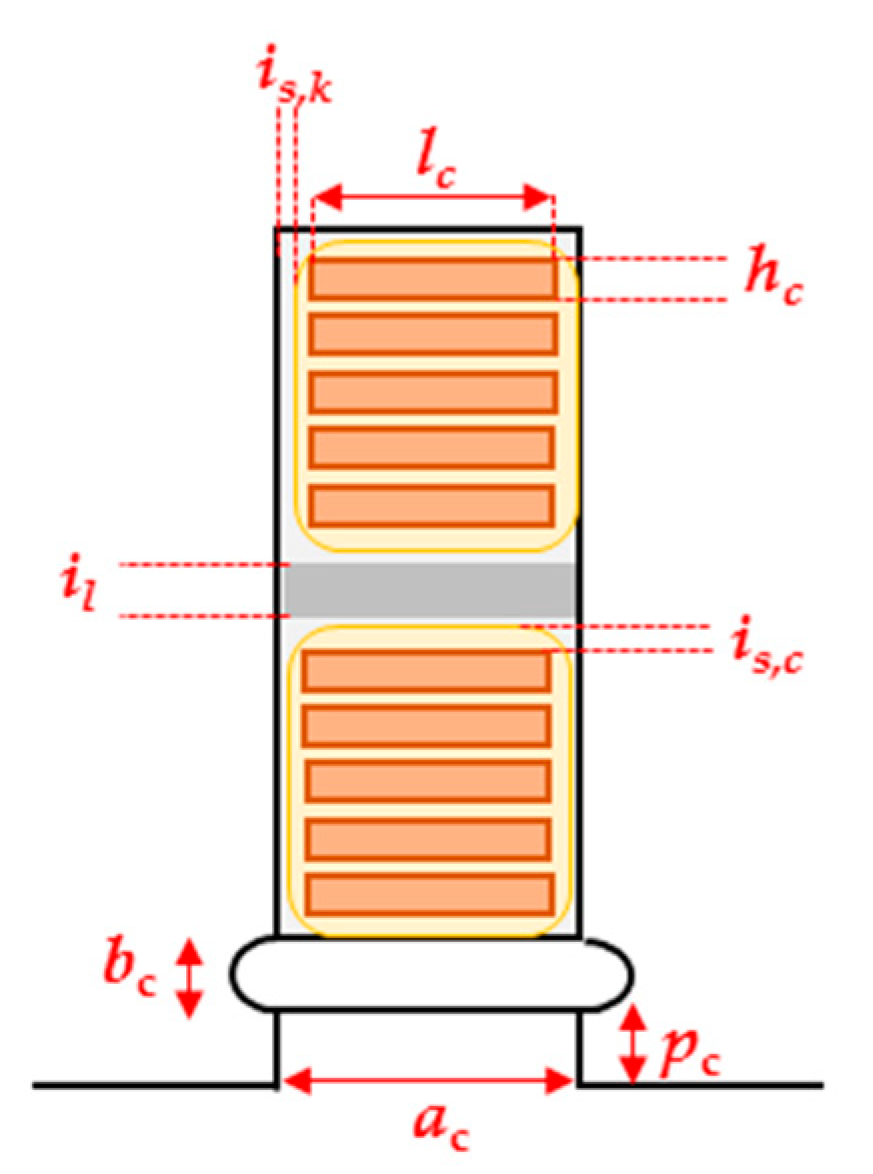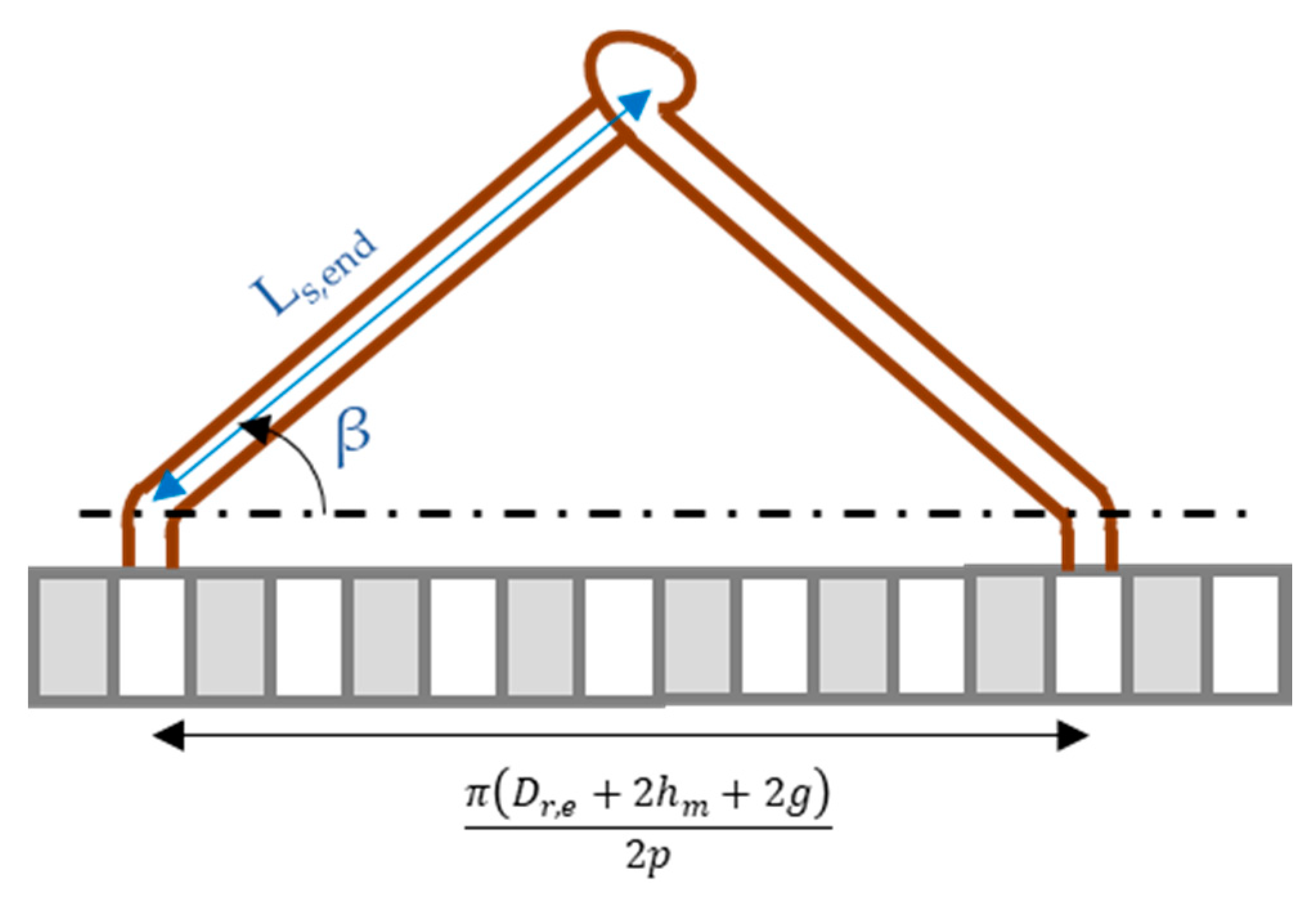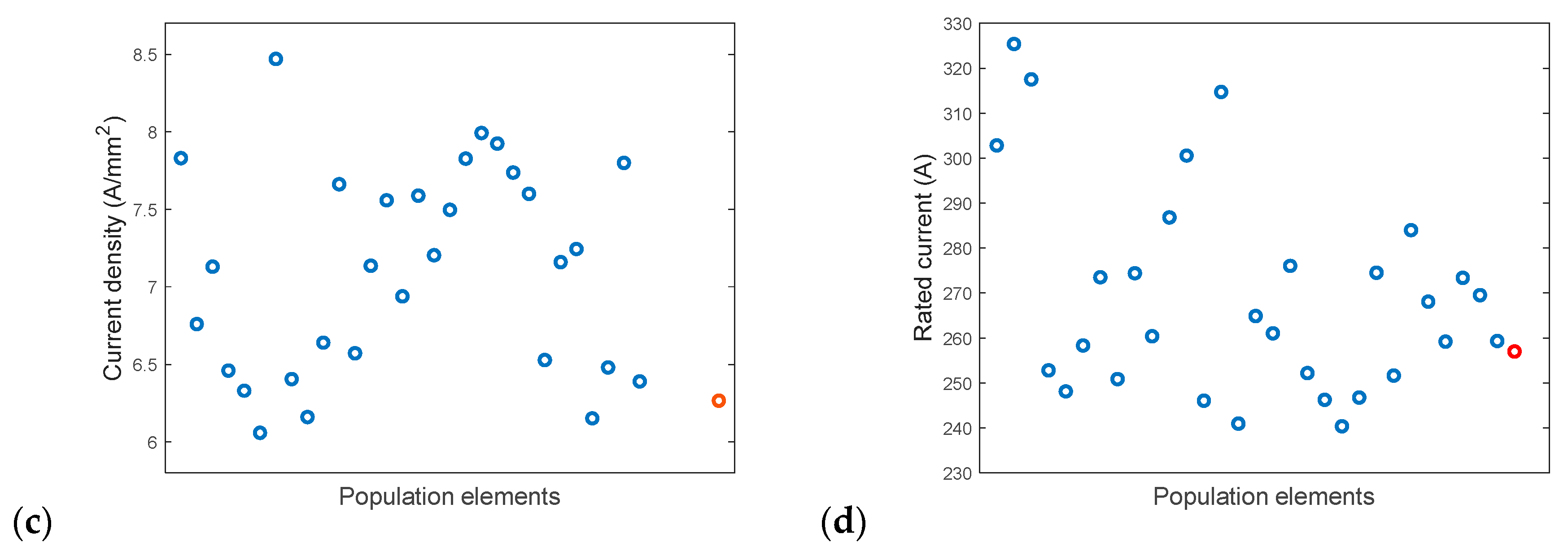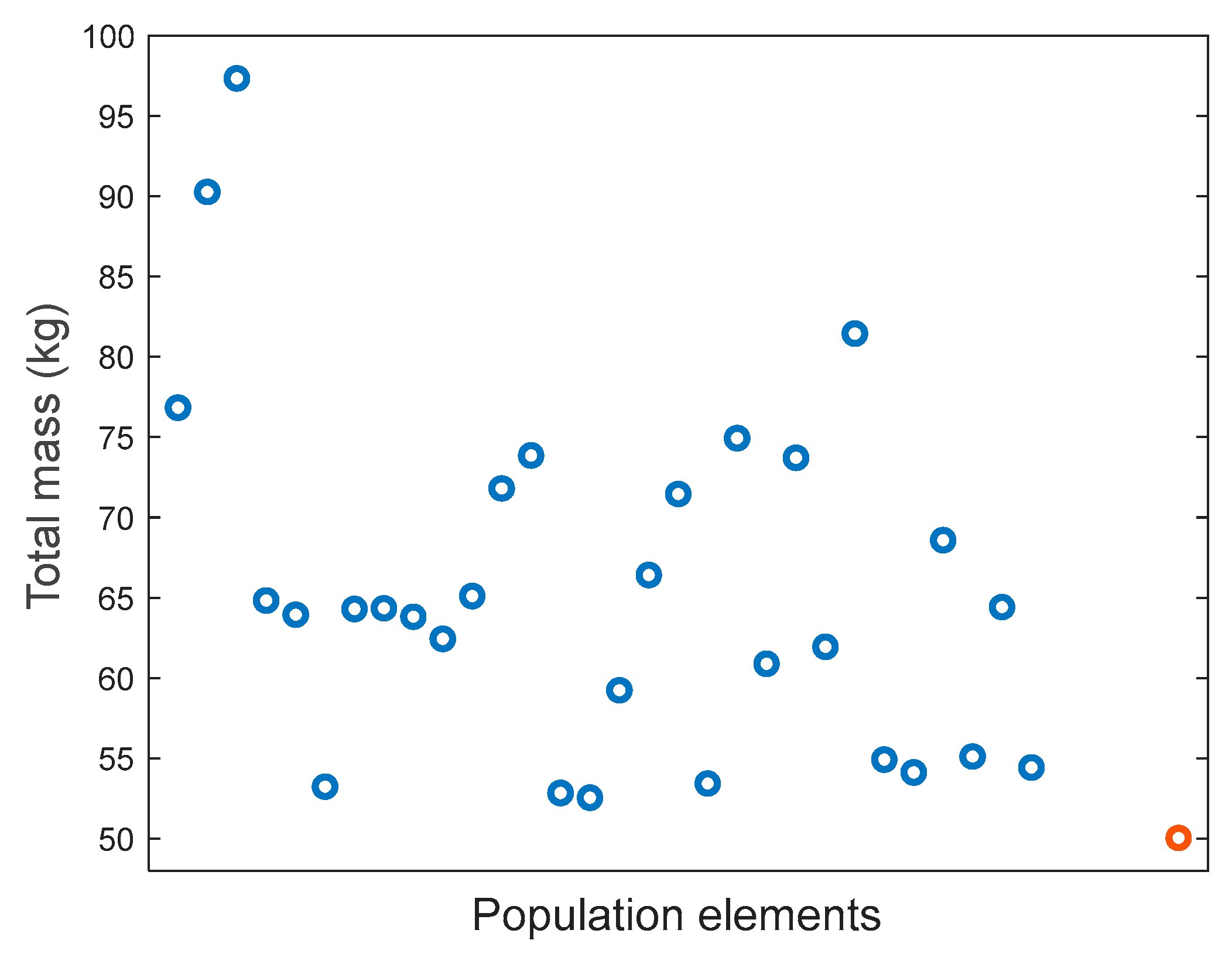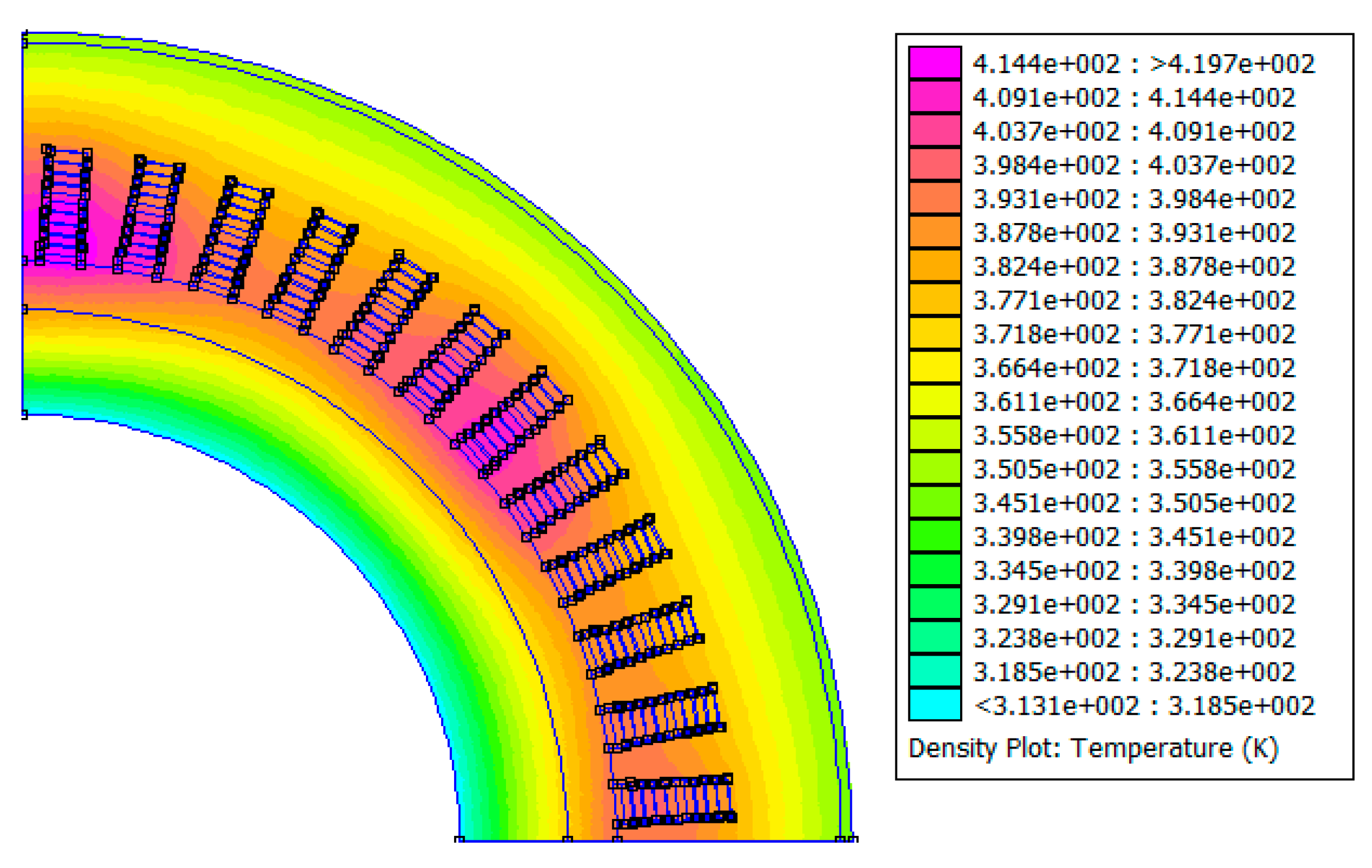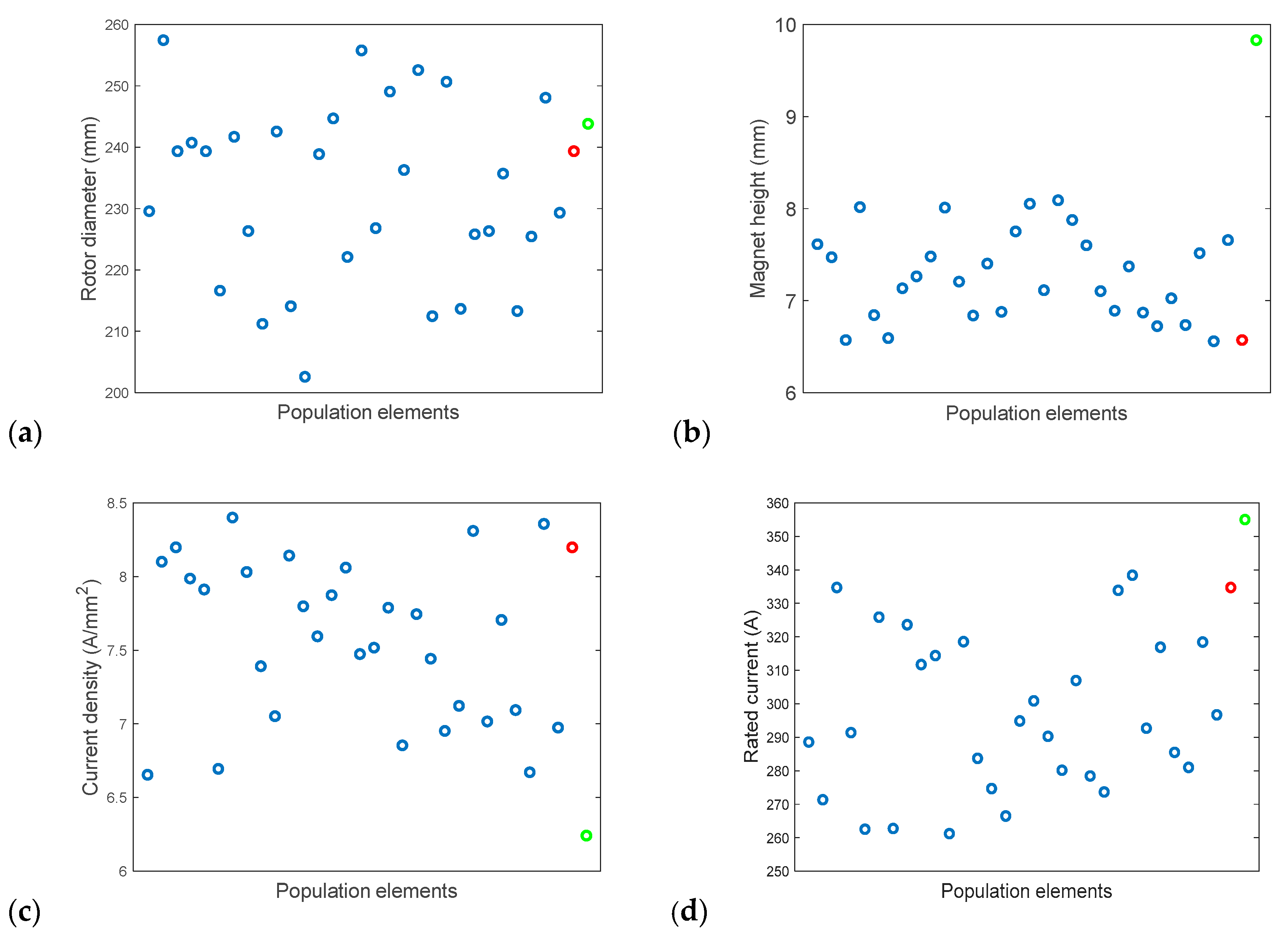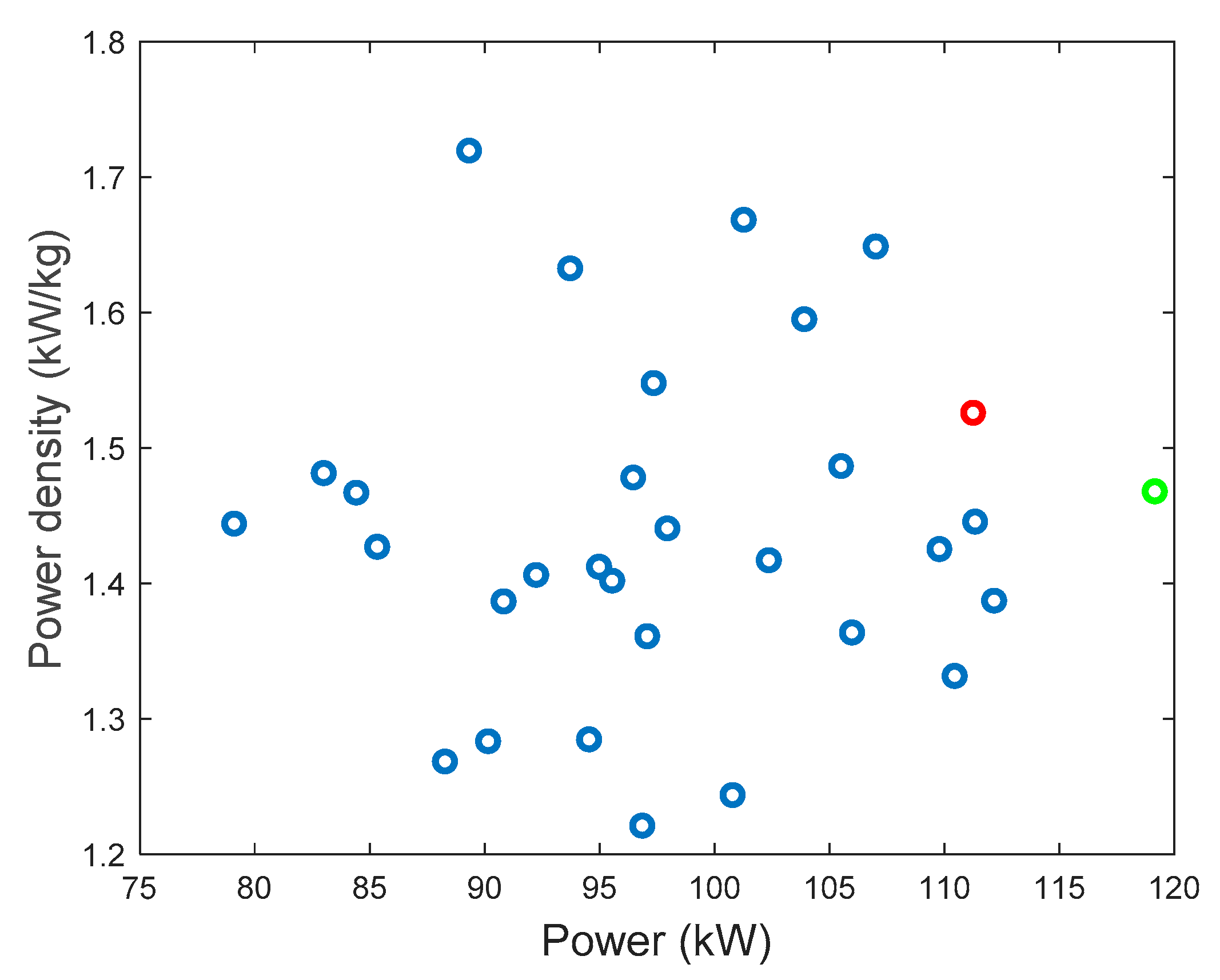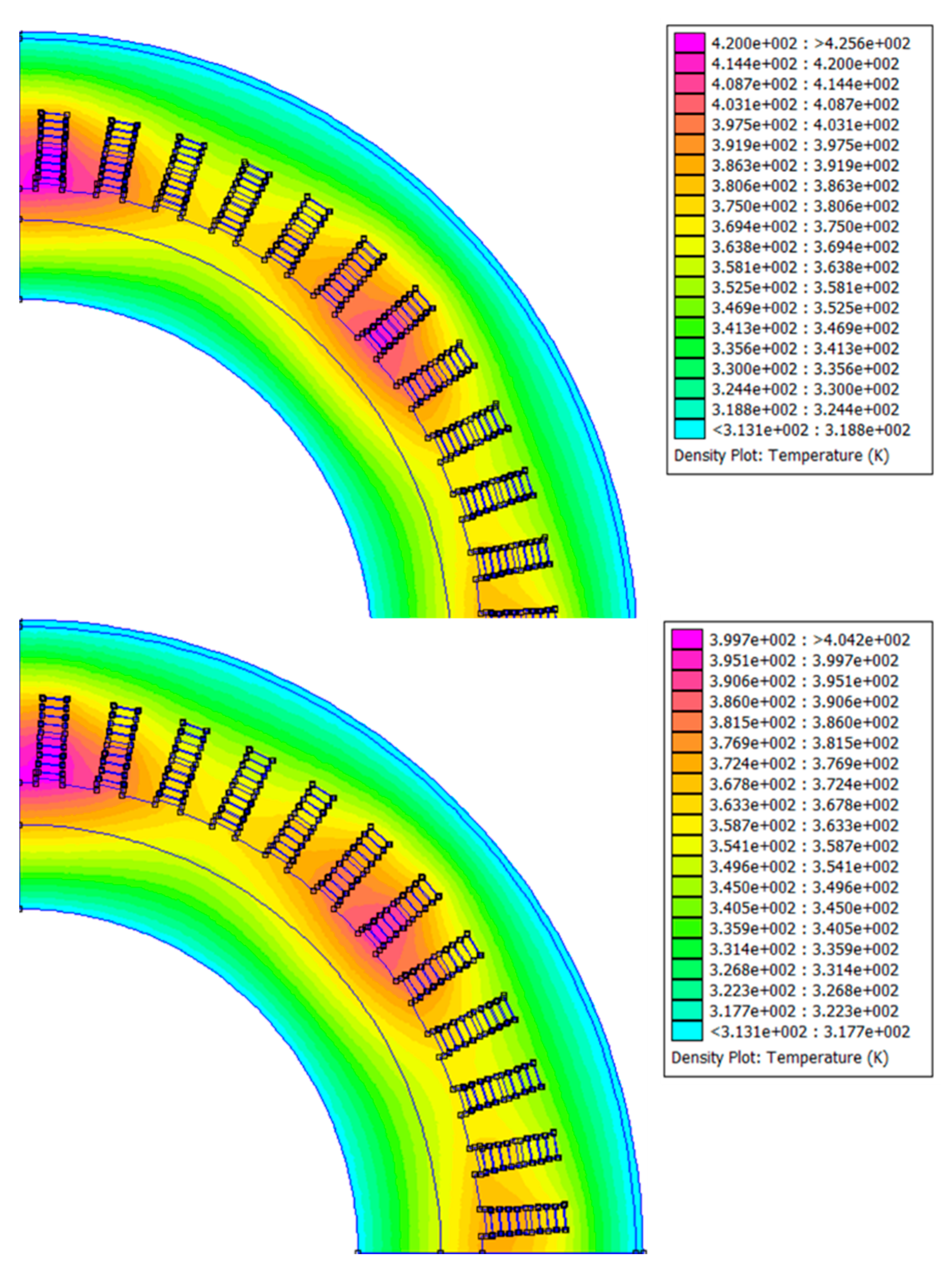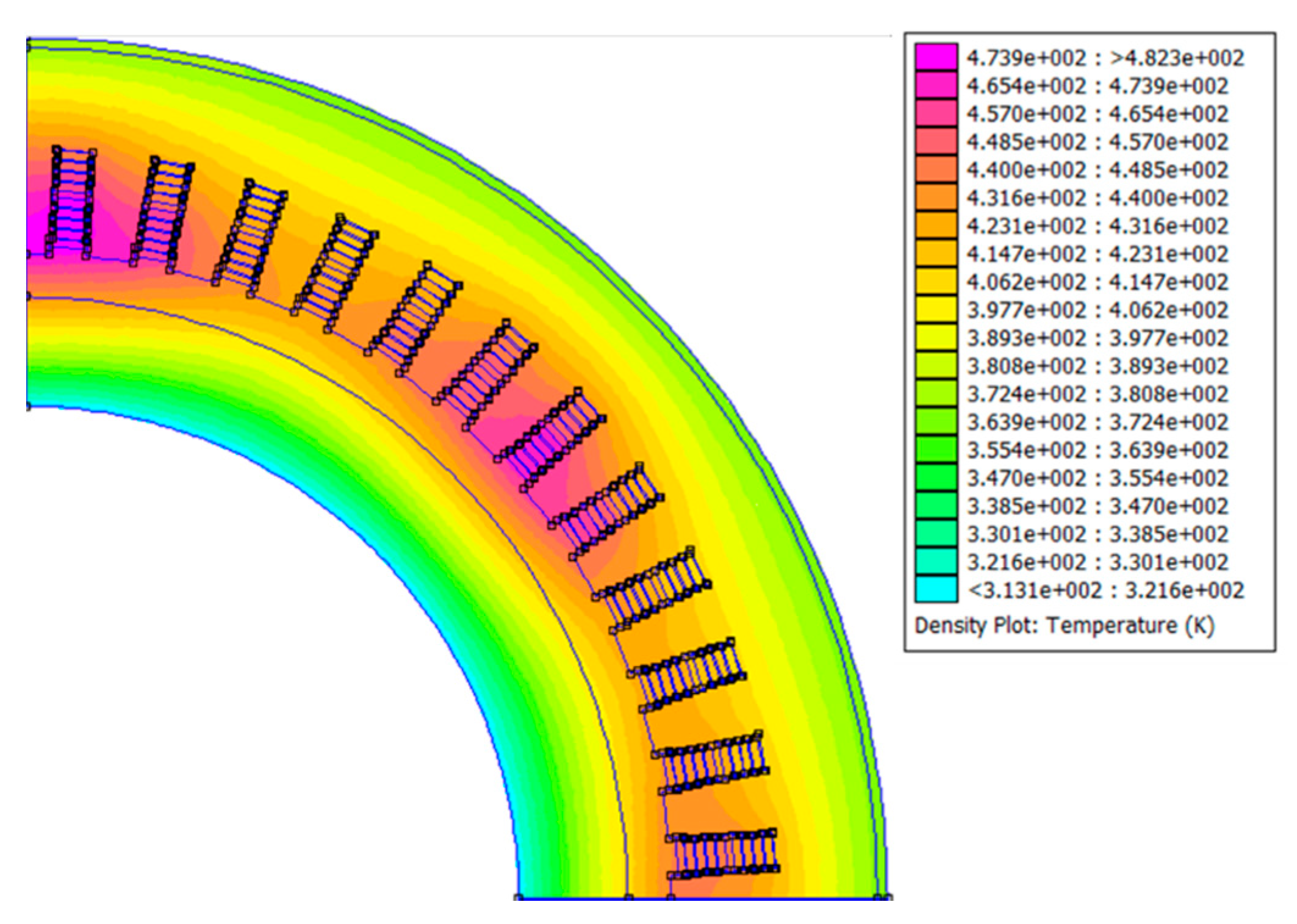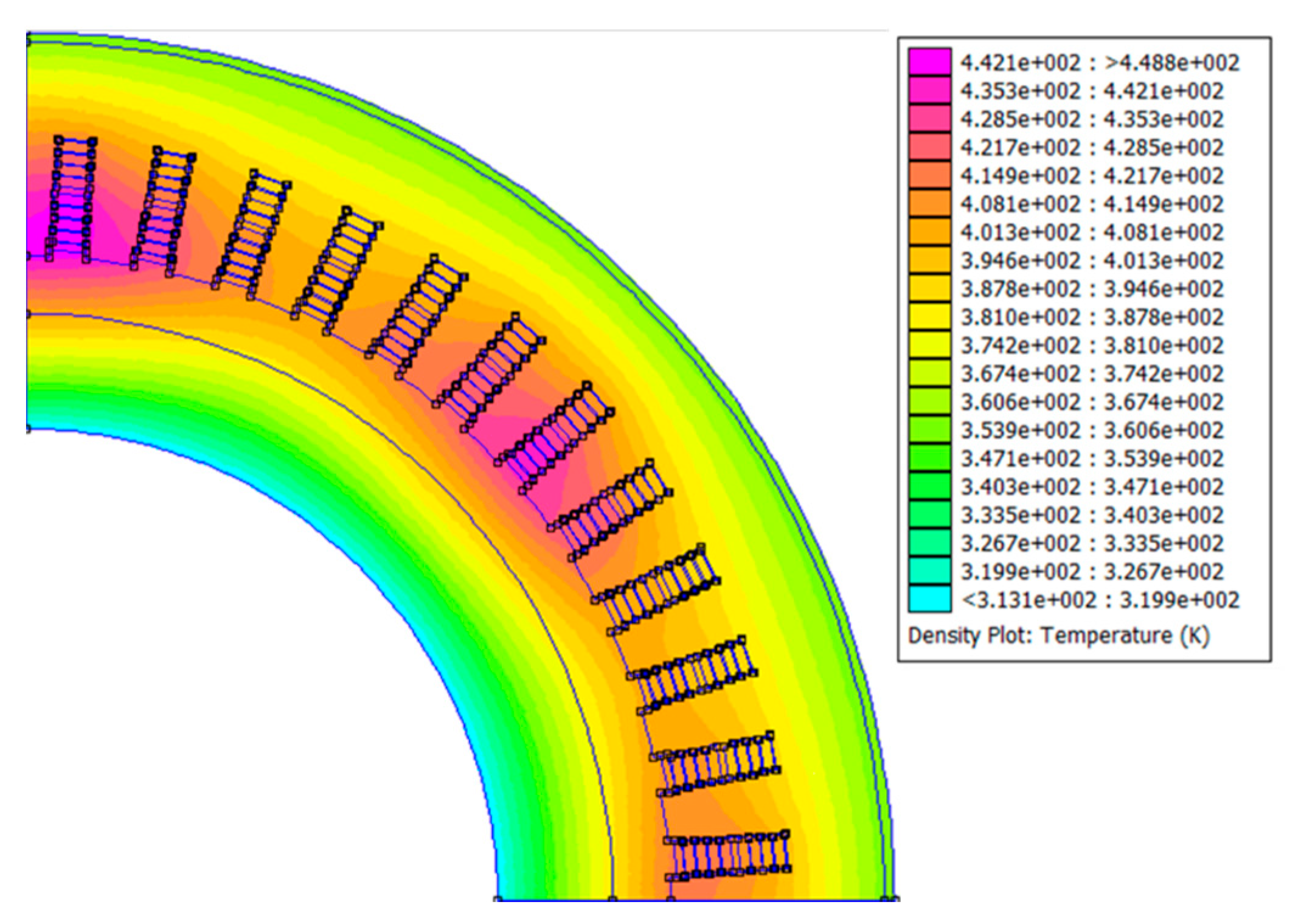As previously described, the design of a propulsion motor for hybrid/full electric aircraft is quite complex with respect to an industrial motor for the thermal problem and the necessity to reduce the weight. The greatest part of the propellers used in aircraft have a hydraulic system able to modify the angle pitch and keep the angular speed of the propeller constant. The constant speed (or a strict variation speed range) is an advantage in the design of propulsion motors with respect to the traction application [
27] where a good performance in terms of efficiency must be guaranteed in a large range of angular speeds. The optimal solution for a propulsion motor can be obtained using a multiphysics approach, able to merge the magnetic and thermal problems at the same time. A precise and affordable solution can be obtained with finite element analysis (FEA), both for the magnetic and thermal analyses. As it is well-known, the FEA needs a high computational cost and a large simulation time, but it is feasible for solving an optimization problem by means of heuristic optimizations able to reduce the number of iterations required for the evaluation of a cost function under given constraints. One of the most adopted methods is based on the differential evolution (DE) algorithm [
28], which is proposed in many variants and used in the field of electrical machines [
29,
30]. The DE algorithm starts from an initial population of a certain number of electric motors with similar characteristics, which can be generated randomly or using the value of existing motors. In our cases a mixed method is applied. Starting from an existing electric motor with the same rated speed and with a similar rated power, and self-ventilated cooling. As it will be shown in the next paragraph, the proposed optimal design methodology is based on a low number of considered design variables. This is due to the necessity of reducing the computational cost: therefore, the use of some characteristics inherited from existing machines appears necessary. In particular the magnetic stack length, the magnet pole arc, the number of slots (
Q), and the number of turns per pole and per phase (
Ns,p) are maintained fixed and extracted from the existing motor.
3.1. Determination of Initial Population
The initial population is generated following the next steps:
(Step 1) Using the main parameters of an electric motor of rated power
P and rated angular speed
ωr,n the external rotor diameter
Dr,e, the current density in the conductor
J, the rated current
In, and permanent magnet length
hm are chosen as random variables:
In Equations (17)–(20), the functions unifrndint and unifrnd generate a random integer number (lower than np, which indicates the number of population elements) and a real random number (lower than 1) using a uniform distribution. The ranges , , , and could be chosen or with the use of analytical formulation or through some initial simulations able to find an opportune maximum value of the parameters. The latter solution is adopted in the paper.
The decision to consider as random variables both the current density and the rated current of the machine comes from the necessity to find possible solutions which satisfy both the thermal problem and voltage limits: It is necessary to highlight that with respect to the voltage limits, in aerospace propulsion it could be quite difficult to satisfy due to the limited value of DC bus voltage (in our case it is considered the value of 270 V), mainly when the requested speed and power are high.
The check of voltage limits passes through the calculation of the back-emf and the synchronous inductance of the motor. The back-emf is calculated by means of Faraday’s law and determining the rotor linkage flux
Φr. For a 2D finite element analysis, the rotor linkage flux with a single-phase coil is calculated as [
31,
32]:
where
Ss is the slot area,
A(z) is the z-component of the potential vector of magnetic flux density, and
L is the stack length of the machine. The integral in (21) is numerically computed on both forward (s
f) and backward (s
b) sides of the phase coils. The derivative versus time of expression (21) provides the back-emf
From a sizing point of view, two variables act on the variation of the back-emf value: the rotor diameter and the permanent magnet length.
The value of synchronous inductance
Ls is calculated with the knowledge of the electromagnetic energy
Emot in the airgap and in the slots [
31,
32]. Considering the permanent magnet without the magnetization, the
Emot can be determined by imposing a quadrature axis current of amplitude
In and using the following relations: (it was verified that with a d-axis current, the value of mutual inductance of the considered motor is the same).
For the machine with a superficial permanent magnet, it is often verified that the direct and quadrature axis inductances are very similar. Therefore, only the computation of Ls with the quadrature current axis has been performed.
(Step 2) In the second step the complete sizing of the motor is carried out.
(Step 2.1) Therefore, the determination of conductor area
Sc, the stator (
) and rotor (
) yokes are carried out using the formula proposed in [
33,
34]:
where
p is the number of pole pairs,
g is air gap length,
Bg,
By,s and
By,r are the maximum values of magnetic flux density in the air-gap, stator yoke, and rotor yoke.
(Step 2.2) The number of pole pairs is chosen as the possible higher number according to the optimal frequency of the converter (
fconv) and the maximum speed of the motor. As previously mentioned, the range variation speed in the proposed application is very tight, and the maximum speed equal to the rated speed (ω
r,n) of the motor can be imposed. From this, the number of pole pairs is calculated as:
In our case, the number of pole pairs is equal to the pole pairs of the initial motor parameters using for the generation of population. If this value was different, a new reconfiguration of windings and of the number of slots should be necessary, with an increase in the number of unknown variables.
(Step 2.3) The air-gap length is calculated starting from the optimization variable
hm and imposing an opportune value of maximum flux density in the air gap
Bg,max (in this paper is imposed equal to 0.8 T). In particular for a PMSM with sinusoidal air gap flux density, the air gap length is obtained as [
35]:
where
Br is the residual flux density of the magnet at the design temperature.
(Step 2.4) The slot height depends on:
- -
the insulation thickness between two conductors is,c and the thickness of the film between the coils and the slot is,k
- -
the slot opening length ac;
- -
the slot opening height pc;
- -
the wedge thickness bc;
- -
the insulation between two different layers il;
- -
the fill factor kcu fixed to 0.60;
- -
the number of conductors in the slots and their main sizes
hc and
lc. The dimension of the conductor is obtained from the area
Sc using the dimension available from the commercial catalogue. The
lc is always selected so that:
- -
the slot edge;
In our case, an open rectangular slot with bar conductors is considered and shown in
Figure 2:
The slot height is determined using the following relations and the feasibility of the slot is verified through the realization of 2D CAD in the pre-processing of finite element analysis.
The parameters is,c, is,k, and il depend on the type of insulation and their values are below 1 mm. The wedge thickness and the slot opening are not modified with respect to the reference motor, and in our case are both 1 mm. Besides the ac depends on the internal diameter of the motor (equal to ) and by the maximum value of magnetic flux density inside the tooth.
In the presented paper, two different sizings are carried out and will be presented in
Section 3.2:
- (a)
the first one with conservative values of magnetic flux density peaks in the iron are used in the paper (1.4 T in the tooth, Bt, and 1.1 T in the rotor and stator yokes). This is due to the necessity of reducing the iron losses and guarantees an overloadability of the motor; this aspect is not treated in this paper and will be the topic of further investigations.
- (b)
In the latter sizing procedure the values of 1.7 T in the tooth and 1.5 T in the yokes are adopted.
(Step 2.5) End windings’ mass calculations: the length of the end winding of the motor is obtained with the approximated formula:
Figure 3 shows a linearization of the machine and of the end-windings.
The angle β also depends on the manufacturer’s quality and in our case is fixed at 45°. A safety factor of 1.2 is adopted in the calculation. The mass of the end windings are calculated as:
where
Ncc is the number of conductors per slot,
Q is the number of slots, and
is the mass density of copper (kg/m
3). The weights of the resin and of the insulation are negligible with respect to the copper’s weight.
(Step 2.6) Calculation of total mass: the total mass of the motor is the sum of the mass of the end windings, the mass of the active windings, and the iron part. The mass of the end windings is calculated with relation (30), while the active winding mass and the iron part’s mass are calculated by evaluating the volume from the 2D CAD of the motor.
(Step 3) The motor obtained with the processes in Steps 1 and 2 is analyzed by means of a magnetostatic FEA. The outputs of the analysis are the rated electromagnetic torque, the back-emf at the rated speed, and the synchronous inductance of the machine. With the AC magnetostatic analysis it is also possible to compute the iron losses and the joule losses in the conductors. For the iron losses, the five parameters formula is used [
36]:
where the parameters
Fskin,
a1,
a2,
a3,
a4,
a5, and α depend on the adopted magnetic sheets and can be calculated from the specific curve losses of the material or through experimental tests;
f is the supply frequency; and
B is the magnetic flux density in the iron.
The joule losses in the conductor are calculated using the following relation:
where σ is the conductibility of the conductors and the distribution of current density in the conductor
Jc(
x,y,z) is calculated taking into account the skin effect of the conductor at the rated supply frequency. The current density
Jc(
x,
y,
z) (which become dependent only by z in 2D geometry) is obtained through the solution of the following equation:
which permits calculation of the current density distribution
Jc = Jc(x,
y,
z) inside the conductor. Using the calculated current density, the numerical calculation of (32) on the conductor mesh, gives the total joule losses. In the proposed approach, the losses in permanent magnets are neglected.
The electromagnetic torque and the losses are used for the calculation of the rated power while the back-emf and the synchronous inductance are used for the verification of voltage limits. If the voltage limits are not satisfied, the variables (17–20) are discarded and a new iteration starts using another initial configuration (see
Figure 2).
(Step 4) The last step for the generation of initial population is the verification of thermal limits. Using the Equations (14) and (15), the heat transfer coefficients are calculated for an altitude of 100 m and for an appropriate speed of air stream. The solution of thermal problem (16) with the FEA gives the temperature distribution in the main part of the motor. If the maximum temperatures satisfy the imposed maximum value in resin and in the windings, a new element of the initial population is found.
3.2. Optimization Problems
The sizing methodology proposed is applied in two different optimization problems: the first is a single objective problem and the second is a multi objective problem. For each problem, the initial populations have been generated using the procedure explained in
Section 3.1. The objective functions are inherent in the following:
| Problem 1 | Problem 2 |
| |
subject to the following inequalities constraints:
Mechanical constraint:
| Problem 1 | Problem 2 |
| |
where Pmin and Pmax are the lower and upper limit allowed for the rated power of the motor
Magnetic constraints:
| | Problem 1 | Problem 2 |
| Bt | 1.4 T | 1.7 T |
| By,s, By,r | 1.1 T | 1.5 T |
Electrical constraints:
Due to the integration of optimization problems with FEA, all the equality constraints are transformed in inequalities, by means of the introduction of a range of variations, as it is shown for the mechanical constraints:
where
ηtarget is the lower value of admissible efficiency, while
Vl is the maximum value of supply voltage,
Ls is the synchronous inductance,
ωr,n is the angular speed, and
is the linkage rotor flux.
Thermal constraints:
where
Tend-wind and
Twind are the maximum temperatures calculated though the 2D FEA in the end-windings and in the windings inside the magnetic stack, while
Tmag is the maximum temperature in the magnets. The
Tmax,wind and
Tmax,mag are the limit temperatures imposed by the insulation class and the type of magnets adopted. In order to apply the 2D FEA, the length of the machine is divided into three parts;
Figure 4: the two parts related to the end-windings (the first part x
0–x
1 is near the propeller, the other one is on the opposite side x
2–x
3) and the last part is the magnetic stack length (x
1–x
2). The three parts are further discretized with step Δx along the axial direction in order to consider the variation of heat exchange coefficient along the external surface. For each disk obtained, the local heat exchange coefficient is calculated according to the Nusselt number [
14,
15].
This procedure permits the reduction of computational cost with respect to the 3D analysis and gives a good precision compromises with respect to the 3D analysis, though the axial heat distribution is neglected.
The DE algorithm used is the type DE/rand/1/bin [
28] (DE: differential evolution, rand: indicates that the individuals selected to compute the trial vectors are chosen as random variables, 1: is the number of pairs of the initial population chosen for the trial vector generation, bin: the binomial crossover is used) and the flowchart for the solution of the optimization problem is shown in
Figure 5. Starting from the initial population, the random generation of a basic vector (or trial vector) is performed using the well-known formulas:
where the scale factor
Fs has been chosen through numerical tests and the parameters
r1,
r2, and
r3 are random integer numbers between 1 and the number of initial population elements.
The “trial motor” is analyzed using magnetostatics and thermal FEA. With the magnetostatic analysis and according to the
Section 3.1, the torque, the back-emf, and the losses in the conductor and in the iron have been calculated. The thermal finite element analysis is carried out at sea-level altitude, where the heat transfer coefficients have been calculated. If all the electrical and thermal constraints are verified and at the same time the crossover verification is positive, the obtained “trial motor” could modify the initial population. The “binomial” crossover check is a further stochastic element adopted in differential evolution able to simulate the biological evolution. It consists of the generation of two random numbers, one real and below 1, and the other (
nrand) integer with maximum value
np. A loop on the number of initial population
np is started and if the real value is lower than the fixed crossover factor (fixed equal to 0.5 in the paper) or the index of the initial population element coincides with
nrand, the check is satisfied. As previously cited, if the constraints and the crossover check are satisfied, the trial motor could be a candidate which can substitute the corresponding element of the initial population substituted with the crossover. In fact, if the value of the objective function is lower (or higher, depending on the optimization) than the objective function of the corresponding index in the initial population elements, the trial motor substitutes the element. Otherwise a new iteration with a new trial motor is performed. The algorithm is repeated for a certain number of substitutions of initial population elements and the adopted stopping criterion is the distribution-based criteria [
37]. In particular, the optimization loop is closed when the difference between the best and the worst values of the objective function of the actual population is below a certain threshold
mth. The threshold
mth is imposed equal to a certain fraction of the difference between the best and worst values of the initial population. At the end, the optimal value is the minimum (maximum) value of objective function obtained in the population. The stop in the procedure could also happen under two other conditions:
- -
the number of times when the constraints are not satisfied (indicated with the counter hconst) exceed the imposed limit itlim;
- -
the number of times when no substitutions happen in the initial population (indicated with the counter hiter) exceed the imposed limit itlim;
These two conditions are usually related to an incorrect generation of initial population and DE parameters (e.g., the constant Fs). In the paper the number of itlim is imposed equal to two times the number of elements in the population.
